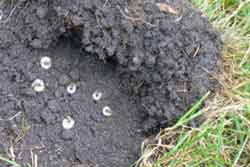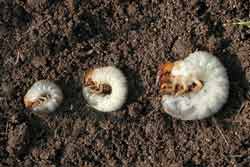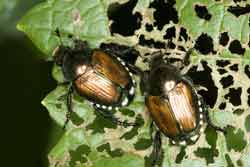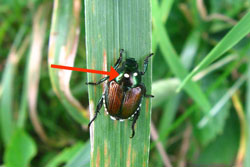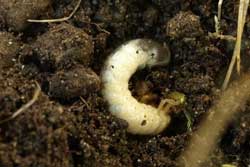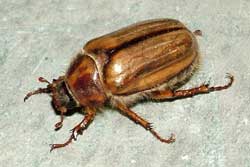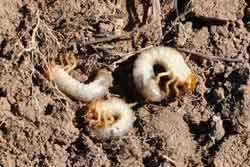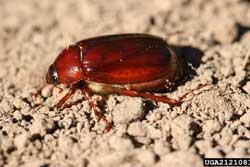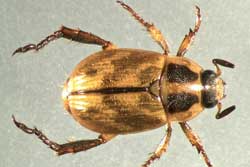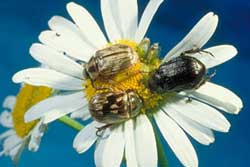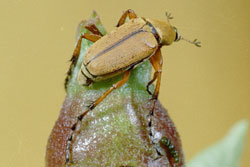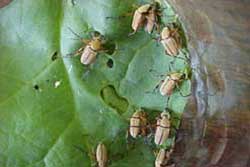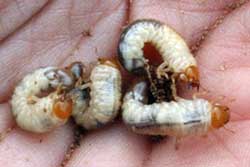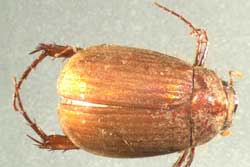White Grubs
White grubs is a general name for the larval stage of beetles in the family Scarabaeidae, order Coleoptera, that feed on the roots of turf. All species of scarab beetles have larvae that are C-shaped and vary in size depending on the species and larval age (instar). Heavy white grub infestations can destroy grass roots, causing the affected area to become spongy, which allows the sod to be rolled back like a piece of carpet. Light infestations do little damage, especially if lawns are healthy. Species of concern in Maine include Japanese beetle (Popillia japonica), European chafer (Rhizotrogus majalis), May or June beetle, also called Junebug (Phyllophaga spp.), Oriental beetle (Exomala orientalis), rose chafer (Macrodactylus subspinosus) and Asiatic garden beetle (Maladera castanea).
It is important to identify the type of grub in your lawn before treating. It is usually necessary to consult an expect for grub identification. Adults are pictured to help with beetle identification. Keep in mind, however, that adults do not always stay in the same area as the larvae.
See also Japanese Beetles
Identification
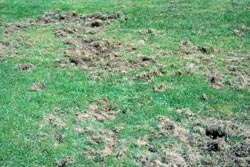
Early indications of grub infestation are irregular patches of dry grass, flocking birds, or areas of turf being torn up by raccoons, possums and skunks looking for a tasty treat.
Japanese Beetles
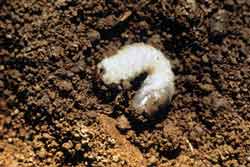
Japanese beetle larvae are typical white grubs that are C-shaped when disturbed. First instar larvae are about 1/16 inch long while the mature third instars are about 1-1/4 inch long.
European Chafers
June Beetles
Oriental Beetles
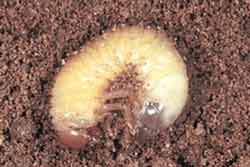
Oriental beetle grubs cause considerable damage to turf grasses and nursery plants. They eat and destroy the roots of the grass and are found in nursery stock, strawberry beds and some outside potted plants.
Rose Chafers
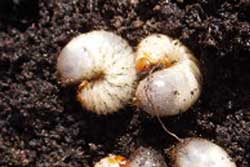
Rose chafer larvae have a brown head and conspicuous legs. Fully grown, a rose chafer larva is about 3/4-inch long. The larvae feed on the roots of grasses and non-crop plants. They do not cause damage to home lawns or landscape plants.
Asiatic Garden Beetles
Click on images to view full-size
Control Information
In many instances, organisms that we deem “pests” may not be pests (some may be beneficial), and other organisms may only be pests in certain instances and control may not always be warranted. In most cases, rats are considered a serious health concern and are considered pests.
Factsheets
- Grubs got your lawn? Before you act, please read this! (PDF)—Maine Yardscaping Partnership
- Grubs in Lawns Factsheet (PDF)—Ontario Ministry of Agriculture Food & Rural Affairs
- Grubs in Your Lawn: A Guide for Lawn Care Professionals and Homeowners brochure (PDF)—The New York State Integrated Pest Management Program
- Common White Grubs of the Northeast (PDF)—The Ohio State University (Excellent resource for grub ID)
- Online click-through grub identification key - Cornell University
- White Grub Problems in Lawns (PDF)—University of Illinois Extension
- Using Beneficial Nematodes for Grub Control (PDF)—Maine Yardscaping Partnership
- Insect Parasitic Nematodes–Ohio State University
- Insect Pests of Home Lawns (PDF)]—University of New Hampshire Cooperative Extension
- Tutorial for Grub Control—University of New Hampshire IPM for Turfgrass
- Control of Japanese Beetle Adults and Grubs in Home Lawns (PDF)—Ohio State University Extension
- Pest Management Fact Sheet: Soil Insect Pests of Vegetables—University of Maine Cooperative Extension
- Fall Management of the European Chafer (PDF)—Penn State Cooperative Extension, Berks County
- Fact Sheet: Rose Chafer (PDF)—North Carolina State University
- UNH Cooperative Extension Info Line Question of the Week: Rose Chafer (PDF)
- Deciduous Tree and Shrub Disorder: Skeletonizing by Rose Chafer (PDF)—University of Wisconsin Extension
- Fact Sheet: Asiatic Garden Beetle (PDF)—University of Massachusetts Extension
- Fact Sheet: Asiatic Garden Beetle (PDF)—University of New Hampshire Cooperative Extension
- Beetles on Ornamental Plants (PDF)—University of New Hampshire Cooperative Extension
Best Management Practices
- Organic and Sustainable Pest Management for Home Lawns (PDF) —North Carolina Cooperative Extension
Milky Spore Disease: A Biological Control for Japanese Beetles
- Does Milky Spore Disease Work? (PDF)—Cornell University Turfgrass Times
- Milky Spore Disease—University of Illinois Extension
- Biological Control: Paenibacullus popilliae, Milky Disease—Cornell University College of Agriculture and Life Sciences Department of Entomology
Dig Deeper - Scientific Studies
- Japanese Beetle (Coleoptera: Scarabaeidae) Invasion of North America: History, Ecology, and Management
Summary: The Japanese beetle, Popillia japonica Newman, was accidentally introduced to the United States from Asia in the early 1900s. First detected in a New Jersey nursery, it is currently established in 28 states in the United States and has been detected in 13 additional states, 3 Canadian provinces, and at least 3 European nations. Adult beetles feed on over 300 host plant species, including many agricultural commodities such as fruits, field crops, and ornamentals, often causing severe economic damage. Authors discuss invasion history, ecology, biology, and management options for this invasive pest species in North America
Think First, Spray Last - Options for Hired Control
In Maine, the Board of Pesticides Control licenses pesticide applicators in several categories. Grub control falls under category 3B (Turf Pest Control). To find a licensed applicator in your area, and search for category 3B and your county.[Photos, left to right: M.G. Klein, USDA Agricultural Research Service, Bugwood.org; unknown; (three grubs) David Cappaert, Michigan State University, Bugwood.org; (Japanese beetle larvae) Jim Baker, North Carolina State University, Bugwood.org; (Japanese beetle adult) David Cappaert, Michigan State University, Bugwood.org; (winsome fly) unknown; (European chafer larvae) unknown; (European chafer adult) unknown; (June beetle larvae) Steven Katovich, USDA Forest Service, Bugwood.org; (June beetle adult) Steven Katovich, USDA Forest Service, Bugwood.org; (Oriental beetle larvae) unknown; (Oriental beetle adult) Mike Reding & Betsy Anderson, USDA Agricultural Research Service, Bugwood.org; (Oriental beetle adults); Ohio State University photo, Dave Shetlar; (rose chafer larvae) unknown; (rose chafer adult); Clemson University - USDA Cooperative Extension Slide Series, Bugwood.org; (rose chafer adults on leaf) University of Wisconsin Entomology; (Asiatic garden beetle larvae) MSU IPM Resources; (Asiatic garden beetle adult) Mike Reding & Betsy Anderson, USDA Agricultural Research Service, Bugwood.org]
